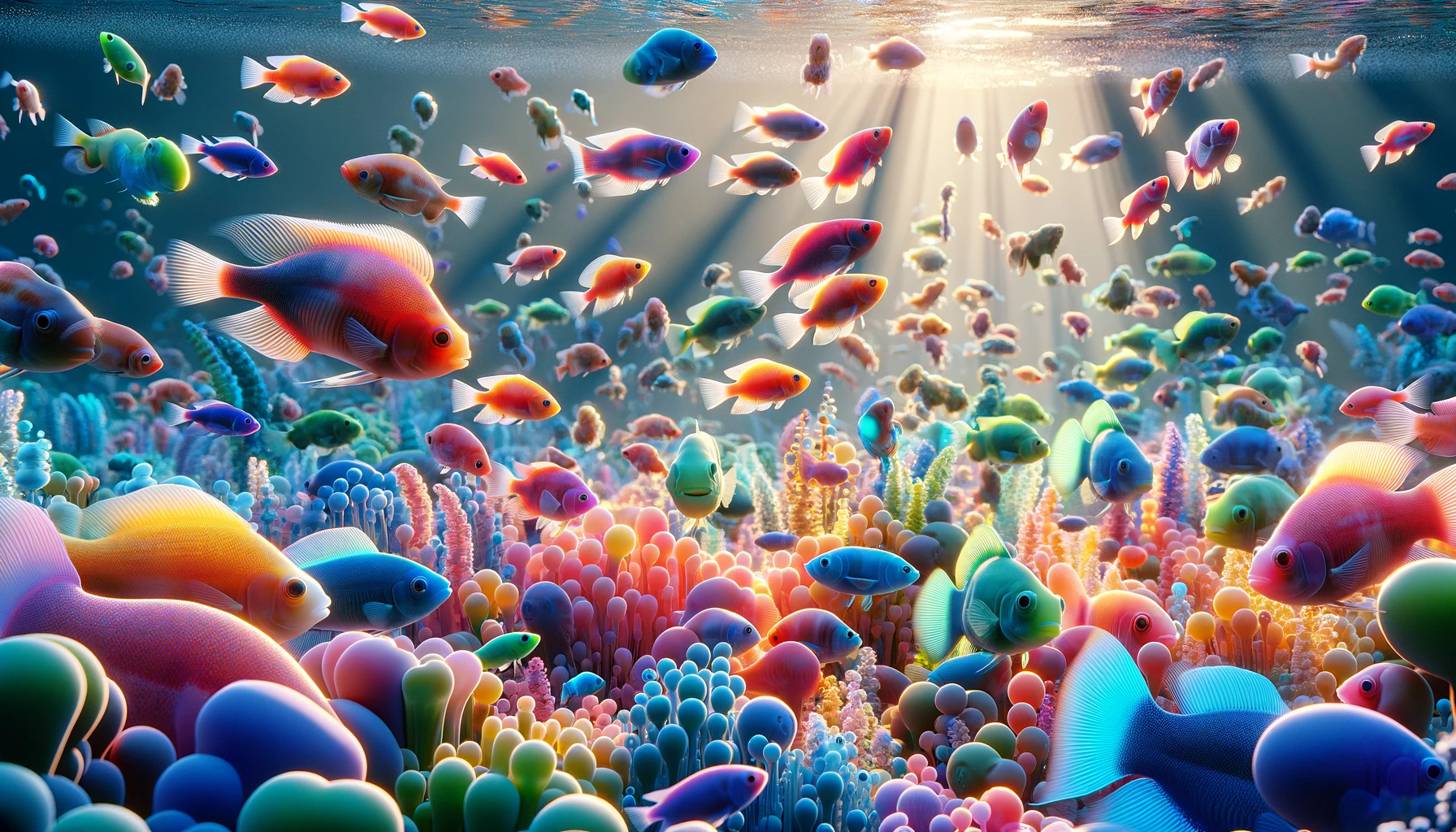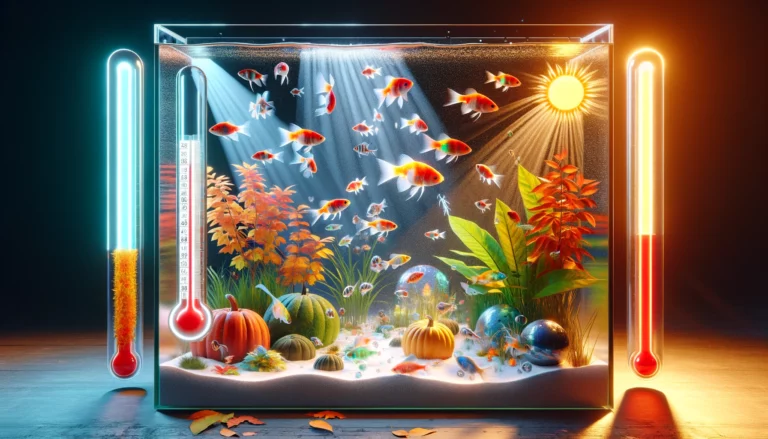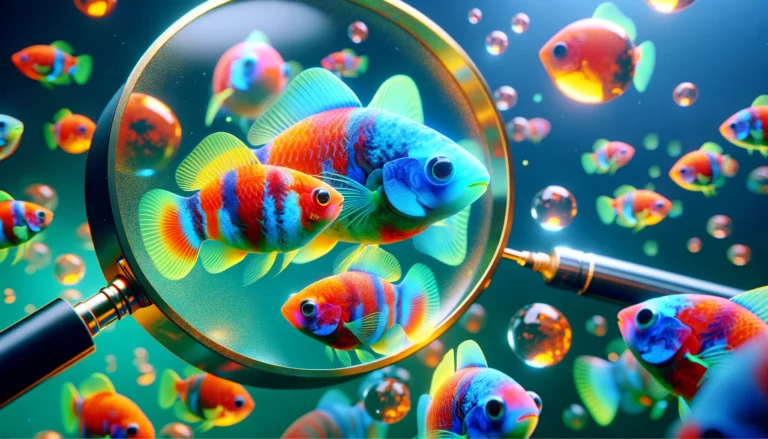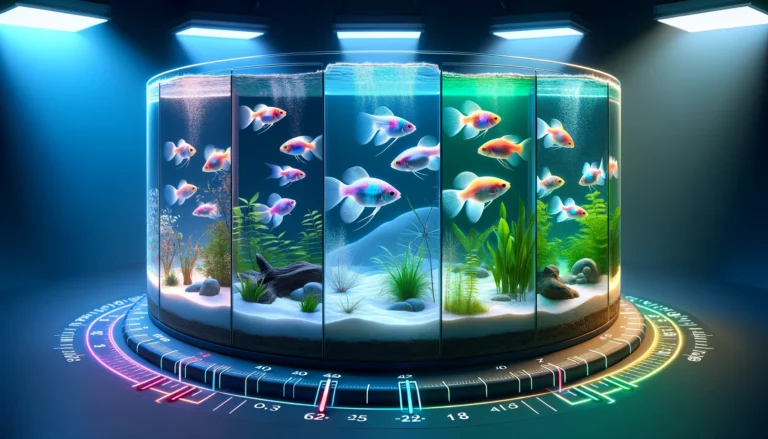Differences in Reproduction between Male and Female GloFish: Anatomy and Strategies
GloFish are vibrant, colorful fish that illuminate home aquariums. Originating from genetic modifications, these fish come in bright neon colors. Their unique glow results from the insertion of genes from fluorescent marine organisms. GloFish are not just a visual delight; they are hardy and suitable for beginners. They adapt well to life in a tank, making them popular among aquarium enthusiasts.
The allure of GloFish lies in their radiant colors and easy care. These attributes make them a favorite in the aquarium community. The range of colors includes pink, green, yellow, and purple. The variety doesn’t stop at colors; GloFish are available in different species like tetras, barbs, and danios. Their versatility and striking appearance contribute to their widespread popularity.
Differences in Reproduction of Male and Female GloFish
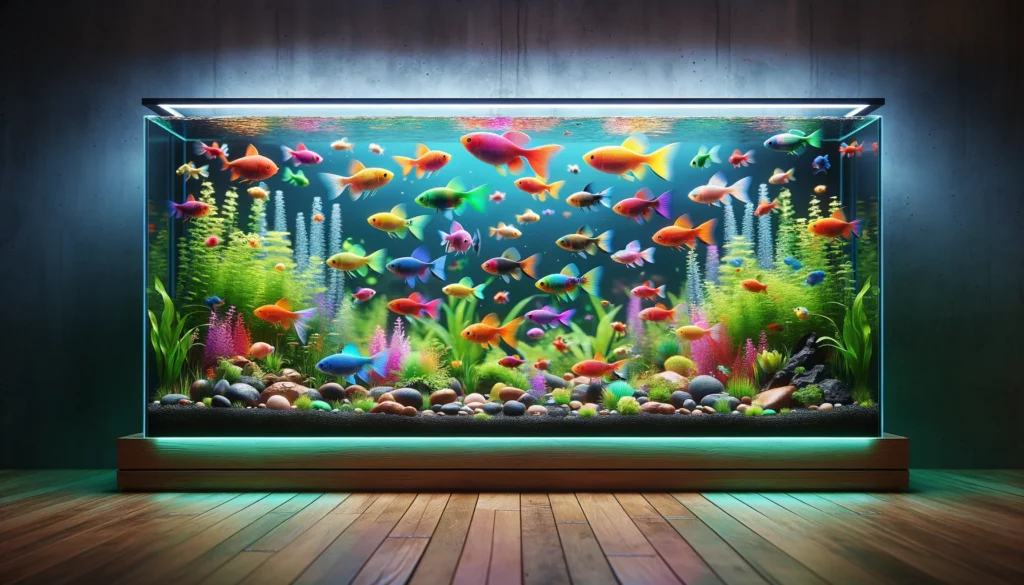
GloFish exhibit distinct reproductive behaviors between males and females. This difference is crucial for enthusiasts interested in breeding. Understanding these differences helps in creating the right environment for successful breeding.
Male and female GloFish show physical and behavioral differences. Males tend to be slimmer and more vibrant. In contrast, females are rounder, especially when carrying eggs. Behaviorally, males often chase females during mating rituals. Recognizing these signs is key for breeders.
The breeding process begins with courtship, led by the male. The environment plays a role in stimulating breeding behavior. A well-maintained tank, optimal temperature, and proper diet contribute to successful reproduction. Once conditions are met, females lay eggs, often hidden among plants or substrate.
Post-laying, care differs between species. Some GloFish, like danios, do not care for their eggs. Others may show protective behavior. It’s essential for breeders to monitor this phase. Proper care ensures the survival and health of the next generation of GloFish.
In conclusion, GloFish are a captivating addition to the aquarium community. Their vibrant colors and ease of care make them a preferred choice. For breeders, understanding the reproductive differences between males and females is crucial. It ensures the thriving of these beautiful creatures in home aquariums.
GloFish are genetically modified fish, famous for their bright colors. They glow under black lights, adding a unique touch to aquariums. Their popularity among aquarium enthusiasts stems from this vivid, fluorescent appearance.
Male GloFish have distinct features setting them apart from females. They are usually slimmer and more streamlined than females. Their colors tend to be brighter. This difference helps in identifying the gender, especially in species like the GloFish Tetra.
The anatomy of male GloFish plays a crucial role in reproduction. Their slimmer body aids in agility, an advantage during mating rituals. The brighter colors attract female counterparts, essential in the mating process. In some species, males display specific fin shapes or patterns, used to entice females during courtship.
In summary, male GloFish’s anatomy and vibrant colors are not just for show. These features are integral in mating and ensuring the continuation of their unique, glowing lineage. Their streamlined bodies and distinctive colors make them stand out, both in the aquarium and during the crucial phases of reproduction.
GloFish are genetically modified fish that glow in the dark. They are popular among aquarium lovers for their vibrant colors. Their unique glow comes from the genes of sea creatures like jellyfish or coral. GloFish come in various species like tetras, barbs, and danios.
It’s important to note that male and female GloFish differ in reproduction. This post explores these differences in depth. Let’s dive into the fascinating world of GloFish!
Features of Male GloFish

Male GloFish are known for their slender bodies. Compared to females, they are often more streamlined. This is true for most GloFish species, such as tetras and danios.
Their color patterns can be more pronounced. In certain species, males may showcase brighter or more distinct colors. This is not just for show. It plays a crucial role in attracting females during mating rituals.
Males often have longer, more pointed fins. These fins are not just for swimming. They are used in mating displays to woo females. The elaborate dances and fin displays are part of the courtship process.
In some species, males might exhibit territorial behavior. This is more than just aggression. It’s a way to show dominance and attract females. A strong, dominant male is often more appealing to a female GloFish.
Features of Female GloFish
Female GloFish are generally fuller or rounder, especially when they carry eggs. This is a clear distinction from the slender males. The fullness is more noticeable when they are ready to spawn.
Their coloration can be less vivid compared to males. This is not a lack of beauty, but a natural distinction. In the wild, this helps them stay less visible to predators, especially when they are carrying eggs.
Females play a crucial role in the continuation of the species. They lay the eggs that males fertilize. The number of eggs and the method of laying can vary between species.
In some species, females might choose the mating partner. This choice is based on the male’s display of colors, fin size, or territory. It’s a natural selection process ensuring strong offspring.
In conclusion, both male and female GloFish have distinct features and roles in reproduction. The males impress with vivid colors and fin displays, while females ensure the survival of the species through careful selection and egg-laying. Understanding these differences enriches the experience of keeping GloFish and contributes to a healthy, vibrant aquarium.
GloFish exhibit fascinating reproduction methods, akin to their non-modified counterparts. These methods depend on the species of GloFish, whether they are danios, tetras, or barbs. Let’s explore the common ways these vibrant creatures reproduce and the conditions that promote their successful propagation.
Reproduction Methods
- Egg-laying (Oviparous): Most GloFish species are oviparous. This means females lay eggs that males fertilize externally. After the male fertilizes the eggs, the parents usually don’t care for them. Species like GloFish danios and tetras follow this method.
- Spawning: Spawning is common among egg-laying GloFish. It involves females releasing eggs into the water. Males then release sperm to fertilize these eggs. The process can happen in batches, with several eggs laid and fertilized over a period.
- Bubble Nesting: Some species, like the GloFish betta, might create bubble nests. Although not common in all GloFish species, it’s a unique method. The male creates a nest of bubbles at the water’s surface. Here, he protects the eggs after the female lays them.
Conditions and Stimuli for Successful Reproduction
- Water Conditions: Clean and stable water is crucial. The temperature, pH, and hardness should suit the specific species of GloFish. For example, GloFish danios prefer slightly cooler temperatures for spawning.
- Diet: A nutritious diet enhances the health of GloFish. Healthy fish are more likely to reproduce. Foods rich in proteins and vitamins can stimulate the breeding process.
- Environment: A stress-free environment promotes breeding. This includes having enough space, hiding spots, and a well-planted aquarium. For egg-layers, fine-leaved plants or a spawning mop can provide a place to lay eggs.
- Lighting: Proper lighting cycles mimic natural conditions. This can influence breeding behaviors. Some species might prefer longer daylight hours to start the breeding process.
- Population Ratio: A balanced ratio of males to females can encourage mating. Too many males might lead to aggressive competition, while too few might not stimulate the females enough.
Successful reproduction in GloFish requires a combination of proper care, optimal water conditions, and an understanding of their natural behaviors. By mimicking their natural habitat and ensuring their health and well-being, enthusiasts can enjoy the vibrant beauty of GloFish, even through their reproduction process. It’s a rewarding experience that brings the dynamism of aquatic life right into one’s home aquarium.

Sexual dimorphism refers to the differences in appearance between males and females of the same species, beyond the differences in their sexual organs. In many species, these differences can be quite pronounced, affecting size, color, or the presence of certain physical features. GloFish, like their non-genetically modified counterparts, exhibit sexual dimorphism, although it can be subtle and vary depending on the species.
Manifestations of Sexual Dimorphism in GloFish
- Body Shape: Female GloFish often have a rounder and fuller body shape, especially when they are ready to spawn. Males, in contrast, tend to have more streamlined bodies.
- Color Intensity: Males often display brighter and more vibrant colors. This is particularly noticeable during the breeding season when males are trying to attract females. The females might have subdued colors, which can be an evolutionary trait for better camouflage while nurturing eggs.
- Fin Size and Shape: Males may have longer and more ornate fins. In some species, the difference is quite noticeable and is used during courtship displays to attract females.
- Behavioral Differences: These are not physical traits but are still part of sexual dimorphism. Males might show more territorial behavior and can be more aggressive, especially during the breeding season.
Benefits of Sexual Dimorphism in Breeding Context
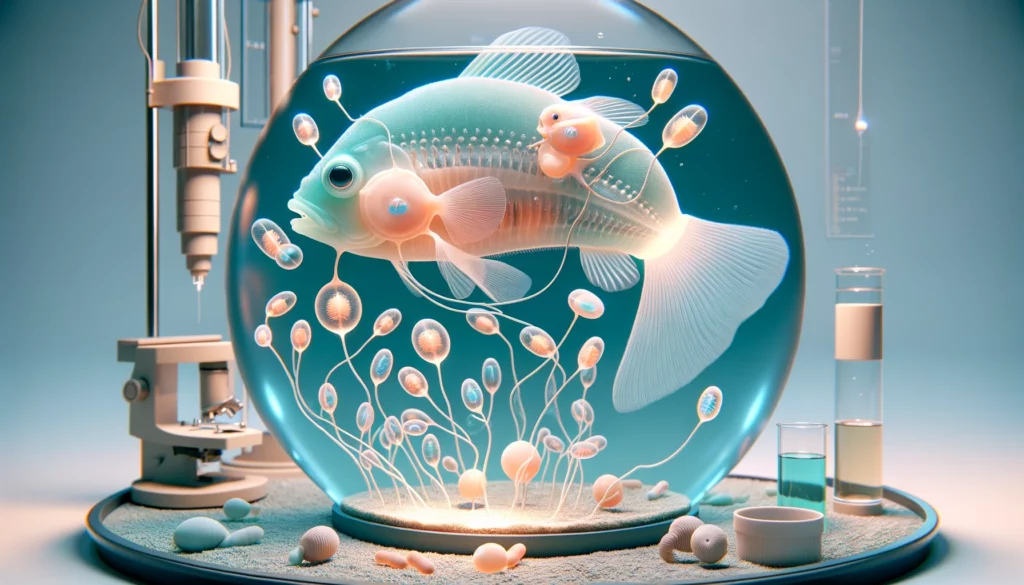
- Mate Selection: Bright colors, large fins, or dominant behavior in males can signal genetic strength, health, and the ability to provide good offspring. Females often select mates based on these traits, ensuring that their progeny have the best chance of survival.
- Reproductive Roles: The physical differences often complement the reproductive roles of each sex. For instance, the fuller body of a female might indicate her readiness to lay eggs, while the agility of the male might be crucial in courtship rituals and protecting the territory.
- Survival Strategy: Sexual dimorphism can be a survival strategy. For example, less vibrant colors in females might help them blend into their environment, protecting them from predators, especially when they are carrying eggs or caring for fry.
In the context of GloFish, understanding sexual dimorphism is not just about appreciating their aesthetic differences but also about ensuring a healthy and thriving aquarium. Recognizing these differences helps in providing the right conditions for breeding and in maintaining a harmonious tank environment. For breeders and enthusiasts, it adds another layer of depth to the fascinating hobby of fishkeeping.
Sexual dimorphism refers to the differences in appearance between males and females of the same species. These differences can be in size, color, shape, or other physical characteristics. In GloFish, sexual dimorphism is quite evident and plays a crucial role in their breeding behaviors and success.
Manifestations in GloFish
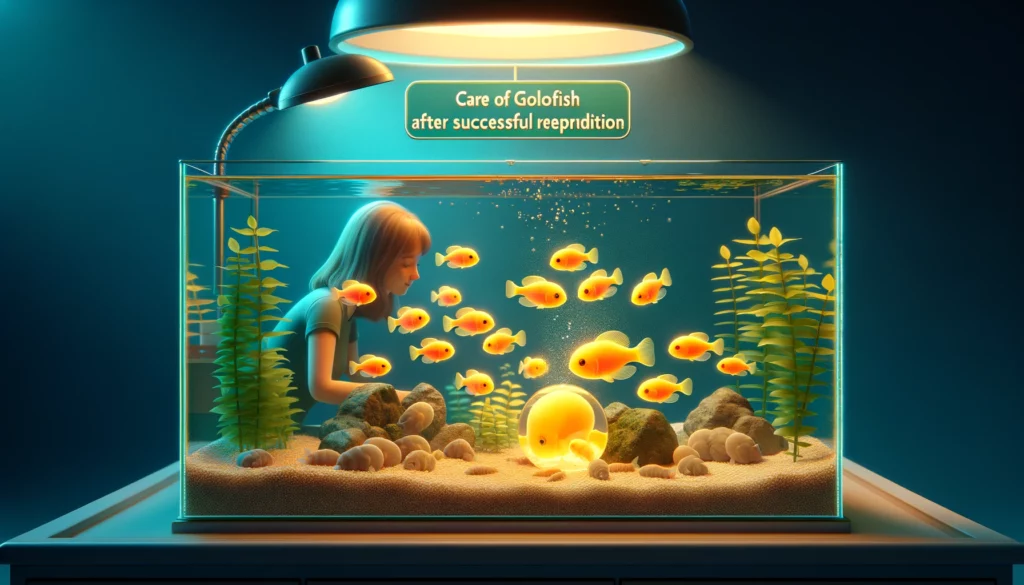
- Coloration: Male GloFish often exhibit brighter and more vibrant colors than females. This is particularly noticeable during the breeding season when males display their colors to attract females.
- Size and Shape: Generally, female GloFish are larger and rounder, especially when gravid (carrying eggs). Males tend to be smaller and more streamlined. This difference is more noticeable in species like GloFish danios and tetras.
- Fin Morphology: In some species, males may have longer and more elaborate fins. For example, male GloFish bettas have longer, flowing fins compared to females.
- Behavioral Differences: Males often engage in more active courtship behaviors, such as displaying their fins and colors or performing specific movements to attract females.
Benefits in Breeding Context
Sexual dimorphism has several benefits in breeding:
- Attraction and Mate Selection: Bright colors and distinct features in males can attract females, facilitating mate selection. This is important in the wild for species continuation.
- Reproductive Roles: The physical differences often relate to their roles in reproduction. For example, the larger size of females is related to egg production and carrying capacity.
- Species Continuation: Sexual dimorphism can enhance genetic diversity. It ensures that only the fittest and most adaptable individuals mate, contributing to the species’ survival.
In conclusion, sexual dimorphism in GloFish is not just a visual treat for aquarium enthusiasts but a vital aspect of their breeding and survival. Understanding these differences is key for anyone interested in breeding GloFish, as it aids in proper mate selection and care during the breeding process. This knowledge contributes to the health and well-being of these vibrant creatures in a home aquarium setting.

In summary, GloFish present a vivid and captivating world of differences, especially when it comes to reproduction. Male and female GloFish are distinct not only in their glowing appearance but also in their roles and behaviors during the breeding process. Males tend to be more streamlined and vibrant, using their colors and fins in elaborate courtship displays to attract females. Females, on the other hand, are generally rounder, particularly when carrying eggs, and their selection in the mating process ensures the continuation and health of the species.
Sexual dimorphism is a fascinating aspect of GloFish, with males and females exhibiting different physical and behavioral traits. These differences are not just for show; they play a crucial role in the breeding process. The bright colors and elaborate fins of males are designed to attract females, while the size and shape of females are adapted for carrying and laying eggs.
For aquarium enthusiasts, understanding these nuances is not just about ensuring the health and well-being of their GloFish; it’s about appreciating the intricate dance of nature present even in a home aquarium. Creating optimal conditions for breeding, considering factors like water quality, diet, environment, and lighting, is essential. But beyond the care, it’s the observation, understanding, and appreciation of these magnificent creatures and their behaviors that truly enrich the experience of keeping GloFish.
So, dive into the study of your GloFish, observe their unique characteristics and behaviors, and create an environment that supports their health and breeding. The world of GloFish is not just about the glow, it’s a vibrant tapestry of life, color, and behavior waiting to be explored and appreciated.

